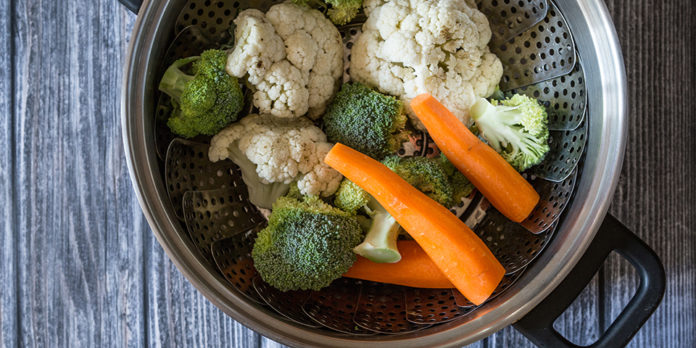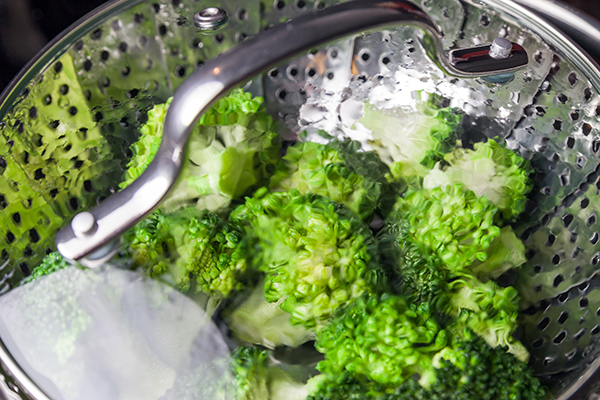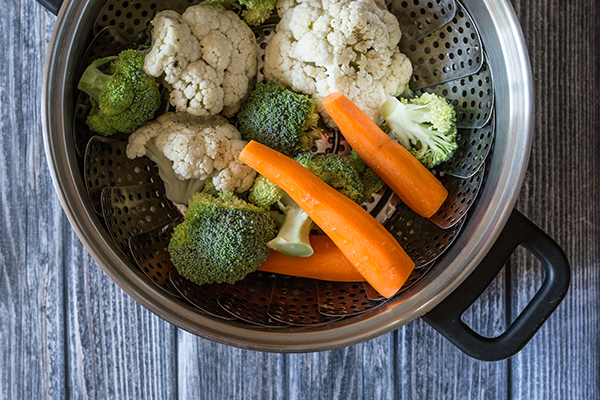Why steam food? Because steaming is a fast, easy, and clean way to cook.
It’s also a moist cooking method, ideal for cooking delicate items like seafood and vegetables.
Similar to an air fryer, which uses the magic of hot air to crisp up food with little or no oil (yay, healthier fries!), steaming uses the vapors of boiling water to cook food.
However, unlike air-frying, steaming is even simpler and requires minimal equipment (although you can also use fancy appliances).
Steaming keeps foods moist and juicy while adding no extra calories or fat.
It’s a health-conscious cooking method, but there are some tips and tricks to steaming food so the end result is tasty and tender — not mushy.
What Types of Food Can You Steam?
Steaming is a way more versatile cooking technique than you may realize — and it isn’t limited to just veggies.
“Steaming foods is a healthy and lean way to cook foods, whether it’s vegetables, fish, poultry, or even dumplings,” explains Emily Sullivan, R.D., L.D. “When you steam food, it very gently cooks the food, making it tender.”
That goes for hearty root vegetables like sweet potatoes, which are a yummy alternative to hash browns with scrambled egg whites for brunch.
Steaming draws out fantastic flavor and texture, says Dr. Christen Cupples Cooper, Ed.D., R.D.N., founding director and chair of nutrition and dietetics at Pace University, College of Health Professions.
The Benefits of Steaming Food
Unlike other cooking methods, such as boiling and frying, your food isn’t submerged in oil or water, which has some surprising benefits.
Along with not adding anything extra to your meal, you’re also not losing as many nutrients and minerals.
“Steaming vegetables is a way to retain water-soluble nutrients since steaming prevents those specific nutrients from seeping out into water if they were boiled,” explains Sullivan.
Vitamin C is an example of a water-soluble vitamin.
“Since food is trapped in a container with steam circulating around it, it cooks very evenly,” she adds.
Are There Any Downsides to Steaming Food?
The only real concerns with steaming food are flavor and overcooking. However, there are lots of ways to jazz up steamed food:
- Steam foods in broth or stock
- Serve with a drizzle of sauce
- Sprinkle nutritional yeast
- Add fresh or dried herbs or spices
The trick for keeping steamed foods healthy is drizzling versus drenching, dipping versus soaking, and sprinkling versus piling on.
You control how much fat or extra calories you’re adding.
Be mindful of how much dressing, dipping sauce, and seasonings you put on your steamed foods, as these may add up with extra calories, added salt, and additional sugar.
If you steam vegetables for too long, they can become limp and soggy.
Steaming cooks food relatively quickly, but it varies based on what you’re making and personal preference.
“Broccoli, for example, cooks in about five minutes, whereas fish takes about four to eight minutes to cook,” explains Elizabeth Gunner, R.D.N.
Always be sure to follow USDA safety guidelines when cooking poultry or seafood.
When it comes to vegetables, doneness is up to you. Crisp-tender is usually ideal but if you like veggies a little softer or firmer, experiment with timing to get your perfect result.
One last caveat: Steam gets hot, so be careful to get too close.
How to Steam Food
Steaming food uses vapors from boiling water to cook food. Water boils at 212 degrees Fahrenheit, or 100 degrees Celsius, in most places (elevation can actually change the boiling point of water) to give you an idea how hot it gets.
On the most basic level steaming requires:
- Boiling water
- Some type of basket or tray to hold the food above the water
- A lid or covering to trap in the steam
“Steam from the boiling water provides heat, which is directly transferred to the food allowing it to cook,” says Gummer. “Simultaneously, when the steam comes in contact with the food, water droplets form and provide moisture.”
Steam also plays a big part in how your pressure cooker works.
There are many tools you can use to steam food on your stovetop, in your oven, in your microwave, and even appliances designed for steaming or multicookers.
Here are some popular options:
- A metal steamer basket in a covered pot on your stovetop
- A bamboo steamer basket in a wok
- A microwave-safe bowl covered with plastic wrap leaving a vent or a lid
- An Instant Pot (using the steam function)
- In your oven with parchment paper packets




























